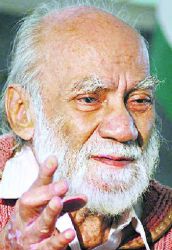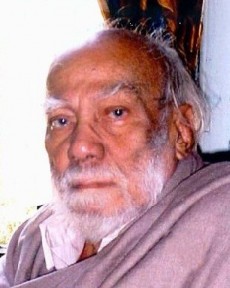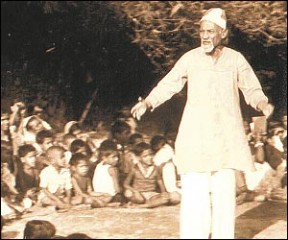Badal Sircar remained, in many ways, the outsider in Indian theatre. He was a prolific playwright, author of more than 50 plays, and the winner of several awards, including the Sangeet Natak Akademi award and the Padmashri. Ebong Indrajeet (Evam Indrajeet, ‘And Indrajeet’, 1963) and Pagla Ghoda (‘Mad Horse’, 1967) are undisputed classics of the modern Indian stage, translated into several languages and performed across the country. They blazed a trail, and opened new vistas. Badal Sircar was a playwright of great power and technical sophistication. Playwrights and directors we consider masters today – Shombhu Mitra, Girish Karnad, Satyadev Dubey, BV Karanth, among others – acknowledged their artistic debt to Badal Sircar. Girish Karnad, for instance, says that he learnt about the fluidity of form from Pagla Ghoda, and Satyadev Dubey says that every play he has done after directing Evam Indrajeet has the shadow of this masterpiece on it.
He was a prolific playwright, author of more than 50 plays, and the winner of several awards, including the Sangeet Natak Akademi award and the Padmashri. Ebong Indrajeet (Evam Indrajeet, ‘And Indrajeet’, 1963) and Pagla Ghoda (‘Mad Horse’, 1967) are undisputed classics of the modern Indian stage, translated into several languages and performed across the country. They blazed a trail, and opened new vistas. Badal Sircar was a playwright of great power and technical sophistication. Playwrights and directors we consider masters today – Shombhu Mitra, Girish Karnad, Satyadev Dubey, BV Karanth, among others – acknowledged their artistic debt to Badal Sircar. Girish Karnad, for instance, says that he learnt about the fluidity of form from Pagla Ghoda, and Satyadev Dubey says that every play he has done after directing Evam Indrajeet has the shadow of this masterpiece on it.
And yet, when he was at the peak of his creativity, hailed as a modern master, Badal Sircar quit and went away.
 He didn’t quit writing, and he didn’t go away from theatre. He quit being a ‘playwright’, and abandoned the urban proscenium stage of psychological realism and the box set, a theatre that showcased the actor and pandered to his ego. That sort of theatre often became, in effect, a vehicle for the actor to show off. In Bengal, the urban proscenium theatre was also overtly verbose. When an actor of the calibre of Shombhu Mitra was on stage, no one minded, because it was a pleasure to listen to him deliver Tagore’s or Badal Sircar’s lines. With his level of virtuosity, you almost felt it was right to show off. It became a drag when lesser actors pretended they had the stuff.
He didn’t quit writing, and he didn’t go away from theatre. He quit being a ‘playwright’, and abandoned the urban proscenium stage of psychological realism and the box set, a theatre that showcased the actor and pandered to his ego. That sort of theatre often became, in effect, a vehicle for the actor to show off. In Bengal, the urban proscenium theatre was also overtly verbose. When an actor of the calibre of Shombhu Mitra was on stage, no one minded, because it was a pleasure to listen to him deliver Tagore’s or Badal Sircar’s lines. With his level of virtuosity, you almost felt it was right to show off. It became a drag when lesser actors pretended they had the stuff.
But then, what was the alternative? Sircar couldn’t simply have embraced the rural theatre. He was city-bred, and he did not want to be an imposter in the rural theatre. So he created what he called the ‘Third Theatre’. This was a theatre that lived and breathed among the common people, that spoke of their lives, that cried their tears and dreamed their dreams. This was theatre for social change. Later, he preferred the term ‘free theatre’ to ‘Third Theatre’. Not only was this term less confrontationist, it was also more accurate.
In the early 70s, the world, especially Bengal, was in turmoil, and this is the turmoil Sircar captured with such precision in his third classic, Michhil (Juloos, ‘Procession’, 1972). He had already formed his theatre group Satabdi, in 1967. Sircar and Satabdi performed their plays anywhere – in large rooms or halls, in the open, in fields, in parks and gardens. This was ‘free’ theatre. It required no ticket to see it, and it required very little money to do. More importantly, it was free in the sense of being free of constraints and obligations. It was insolent, unafraid to speak its mind.
What this theatre did require, though, was imagination. Too much of what goes in the name of ‘street theatre’ (particularly today, when the NGOs have appropriated the form to a great extent) is patronising, artistically weak, imaginatively barren and plain boring. Sircar’s theatre was never barren, intellectually or aesthetically. You might or might not agree with him, but you could not dismiss his theatre. In plays such as Bashi Khobor (Basi Khabar, ‘Stale News’, 1978) and Bhoma (1979), Satabdi created some of the finest instances of ‘physical theatre’ in India.
In other words, in Sircar’s work, writing, directing, and acting in plays became seamless parts of the larger process of creating theatre. And while he continued writing plays, the act of creating theatre involved, more and more, the reconfiguration of the performance space, and manipulation of actors’ bodies and voices to create meaning. Dialogue within the group became for him as important as dialogue in the play and dialogue with the audience.
Satabdi began performing in a room on the second floor of the Academy of Fine Arts three days a week. The room could take about 60-70 spectators, and was named Angan Mancha (‘Space Theatre’) by Sircar. A few months after Angan Mancha came into being, Sircar learnt of theatre taking place in Surendranath Park (formerly Curzon Park) in the centre of the city. A theatre group named Silhouette had started this, and this became Satabdi’s venue as well. Initially, Sircar was sceptical about the audience taking to his plays, which were more complex and sophisticated than the average street theatre being performed there. But he was to be surprised. Over time, a serious and regular theatre going audience developed at Surendranath Park.
Ideologically, it is a little hard to characterise Badal Sircar’s theatre. He started with light hearted comedies (Ballabhpurer Rupkatha being the best known, and is still popular), then went on to express the angst and rootlessness of the urban middle class in his classic plays, and eventually, in his post-proscenium phase, he became more consciously anti-establishment.
 However, a certain sort of political ambivalence is inscribed into his plays and in fact into his dramaturgy itself – in the sense that the non-verbal can just as easily ‘flatten’ meaning and equalise opposites. His theatre could was, variously, angry, nihilist, hopeful and deeply humanist. I am not being pejorative when I say that Badal Sircar’s theatre reflected a certain ‘middle class’ view of life. In fact, it could be argued that this was the result of his deep honesty and self-reflexivity. He didn’t delude himself that he could, in some magical way, transcend his class roots simply by mouthing radical slogans. In talking about his creative journey, he recounts the following:
However, a certain sort of political ambivalence is inscribed into his plays and in fact into his dramaturgy itself – in the sense that the non-verbal can just as easily ‘flatten’ meaning and equalise opposites. His theatre could was, variously, angry, nihilist, hopeful and deeply humanist. I am not being pejorative when I say that Badal Sircar’s theatre reflected a certain ‘middle class’ view of life. In fact, it could be argued that this was the result of his deep honesty and self-reflexivity. He didn’t delude himself that he could, in some magical way, transcend his class roots simply by mouthing radical slogans. In talking about his creative journey, he recounts the following:
‘But should we make a play on the Santhal revolt of 1855-56, taking roles of Santhals and the oppressors? The answer was – no. Then what? We shall show it from our point of view, that is, the point of view of a contemporary person belonging to the city-bred, educated middle class community. Why? Because we want to link that revolt to the present-day reality.’[1]
Sircar’s relations with the organised left remained awkward at best. Utpal Dutt, Sircar’s near exact contemporary and member of the CPI (M), hardly ever spoke kindly of Third Theatre. Perhaps because he was familiar with Dutt’s style, which was somewhat robust and highly polemical, to the best of my knowledge, Sircar didn’t respond to Dutt in kind. Some of his less patient followers did, however, and the mutual suspicion hardened over the years. This was unfortunate, because Sircar made a tremendous contribution by taking quality theatre to non-formal spaces. He was a key figure in what Safdar Hashmi called the ‘democratisation of Indian theatre’.
Above all, what Badal Sircar did was to seed practice and train practitioners. This is a part of his legacy that has not been appreciated enough. But through the 1970s, he travelled all over the country, holding workshops in the techniques he was exploring. The Kannada left-wing theatre group Samudaya (the theatre director Prasanna was associated with it, as was, though not so centrally, Karanth) invited Satabdi for a performance, and followed it up with a two week workshop with Sircar in Kumbulgod. This led directly to Samudaya taking up street theatre in 1978. Samudaya went on to become one of the finest exponents of street theatre in the coming years.
 Or take the case of the Manipuri director, H Kanhailal. Expelled from the National School of Drama because he couldn’t manage either the ‘high’ Hindi expected of him, nor very good English, Kanhailal found his own unique idiom after a workshop with Sircar. It was Sircar who introduced the non-verbal, physical idiom to Manipuri theatre. Sircar had got the psycho-physical exercises of the avant-garde Euro-American theatre from the Polish director and theorist Jerzy Grotowsky. In 1972, Sircar performed four of his plays in Imphal. Kanhailal saw these, and the following year he spent nearly a month in Kolkata, learning these exercises.
Or take the case of the Manipuri director, H Kanhailal. Expelled from the National School of Drama because he couldn’t manage either the ‘high’ Hindi expected of him, nor very good English, Kanhailal found his own unique idiom after a workshop with Sircar. It was Sircar who introduced the non-verbal, physical idiom to Manipuri theatre. Sircar had got the psycho-physical exercises of the avant-garde Euro-American theatre from the Polish director and theorist Jerzy Grotowsky. In 1972, Sircar performed four of his plays in Imphal. Kanhailal saw these, and the following year he spent nearly a month in Kolkata, learning these exercises.
Eventually, though, the student in some ways rejected the teacher. But this was not a simple rejection. Kanhailal learnt from Sircar that to express complex issues and thoughts through theatre, one had to be neither a prisoner of the frills of the proscenium stage, nor of verbose playscripts. An empty space was enough, if the actors’ bodies were expressive, and the spectators’ imaginations could be fired. In a word, Sircar gave Kanhailal the confidence to find his own voice.
But soon, Kanhailal moved away from psycho-physical exercises. The Bengali actor needed to be ‘freed’ from his/her social inhibitions, so that s/he could begin using the body truly expressively. The Manipuri actor was the product of a different cultural milieu. S/he was physically less inhibited, and more athletic and flexible. Then there were other sorts of cultural conditioning. While Sircar encouraged – even demanded – a strong eye contact between the actors and with the audience, in Manipur, eye contact was something of a taboo. But even though he eventually moved away from psycho-physical training, there is no doubt that Sircar had unlocked the founts of Kanhailal’s creativity. Kanhailal’s extraordinary work, including early classics such as Pebet, Memoirs of Africa and, later, Draupadi and Dakghar, could not have been possible without Sircar’s defining influence.
It is an irony that while Sircar’s plays for the proscenium stage remain justly well-known, his post-proscenium career is hazy in the minds of theatre lovers. But perhaps that is how he wished it. He was a man who had walked away from the spotlight. Many think he spent his last years in a sort of retirement and that Satabdi had become defunct. Neither is true. About a decade before his death, Sircar had an accident, which had severe implications on his physical ability to act in or direct plays. What he achieved, though, was to enter into creative, nurturing collaborative relationships with other theatre groups active in and around Kolkata. Some of these groups folded up fast, but two had a long life – Ayna (founded 1978) and Pathasena (founded 1979). Both these groups considered Sircar their mentor, and he played an active role in training them, and sometimes also directing plays for them.
His last years were spent, by all accounts, in some financial difficulty. While some festivals and groups did confer awards upon him, he got no institutional support. We as a nation must hang our heads in shame at this. Too many artists who have played defining roles in the creation of modern India have died in need.
Badal Sircar went the day the Left Front lost. For all his differences with the left, I am not sure he would have relished the prospect of anti-communists coming to power in West Bengal. He timed his exit perfectly.
‘End of an era’ is a cliché. I never met him, but he was a moral compass. He embodied everything that drew me to left wing theatre – the inventiveness of the form, its rough texture, the ability to say a lot with very little, an unwavering commitment to the people, smell of the earth, and of the rain. Habib Tanvir died in 2009, and now Badal Sircar. The touchstones are gone.
Sudhanva Deshpande is an actor and director with Jana Natya Manch, and works as editor with LeftWord Books. He can be reached at sudhanva@leftword.com.
[1] Badal Sircar, Voyages in the Theatre, New Delhi 1993, p. 37. For a detailed analysis of Sircar’s theatre till the early 1980s, see Rustom Bharucha, Rehearsals of Revolution: The Political Theatre of Bengal, Calcutta 1983. A good analysis of his later years can be found in Shayoni Mitra, Badal Sircar: Scripting a Movement, The Drama Review, 48, 3, Fall 2004. For Sircar’s influence on Kanhailal, see Rustom Bharucha, The Theatre of Kanhailal: Pebet and Memoirs of Africa, Calcutta 1992. For his influence on Samudaya, see Narendar Pani, Staging a Change, Bangalore 1979, and Rati Bartholomew, Samudaya’s Jatha, Karnataka.






amazed, as always, at your capacaity for detail 🙂